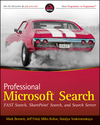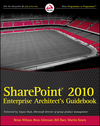If any of you wandering why I have not been writing as much as I did before, here is the answer ;-)
I have been writing, but most of the effort had been focused on the BOOK, that’s right… this is the first book contribution that I’ve done so far (3 chapters). it would not be possible without awesome co-authors and especially Jeff Fried, Jeff is solely responsible for pulling me into this “project”. I’m thankful to Mark and Miles for seeing me as the right fit (did I mention that all 3 of them are awesome?). And since I’ve started thanking people close to me for their tireless support, I’d like to say special THANK YOU to my husband George, who put up with me during the “book” and another chapter and chapter revision time ;-) I was probably the most unbearable person at that time. George, I greatly appreciate all you have done for me and the support foundation that you have built, thank you.
And now without further delay, here is the introduction for my book. Now go and get it ;-), I'll be happy to sign it. there is a special discount to Enterprise Search User group members, join the group and come to our meetings. More information here
This is one of the first books dedicated to comprehensive coverage on Microsoft's new search technology, FAST Search.
• Features an expert group of authors, including the current VP of Products, Jeff Fried, who has been leading the strategic development of FAST search, as well as additional industry search consultants to provide real world guidance.
• FAST technology currently powers, Bing.com, as well as other notable sites: BestBuy.com, six of the top pharmaceutical companies, CareerBuilder, Reuters, and a host of other top tier knowledge based companies search sites.
• This book will provide coverage for implementing and using FAST search for both SharePoint and general search based services providing the broadest coverage for the reader.
| About the topic/technology |
Microsoft's largest purchase to date was when they purchased FAST Technologies for over a billion dollars. Now Microsoft is ready to leverage that investment by fully integrating this intelligent search technology into its existing products.
• FAST Search will be added as an option to the following Microsoft based technologies: FAST Search for SharePoint, FAST Search for Internet Business (a Windows and Linux based server), and the revision of SharePoint Server 2010 using Microsoft's in hose search technology.
• FAST Search has been a noted industry leader and is used not to just find a needle in a haystack, but to find out how big the needle is, what color, its chemical composition, where the needle was manufactured, and its current cost
• The big differentiator between FAST technology and other search technology is its robustness and ability to integrate business intelligence with Search.
The books primary audience would be IT and marketing staff in mid to large sized companies who are interested in understanding enterprise search. The core audience is based on those who are responsible for implementing and managing enterprise search. This is typically composed of both programmers who develop search based applications as well as system architects, managers, and planners who help design, deploy, and test search based systems. A large secondary market is based on Microsoft Certified Professionals who help consult and advise customers on search technology.
| This book will help professional developers, programmers and administrators learn the key features and functions that are available with Microsoft's new FAST Search. The book will provide real world examples that show how the technology functions and can be used to solve key challenges faced in the Enterprise. Throughout the book key coverage will be provided on the following topics: • Enterprise Search and the Microsoft Search Product Line • SharePoint Focused Enterprise Search • FAST Search for Internet Business • The Future of Enterprise Search |
| Table of contents |
| INTRODUCTION. PART I: INTRODUCTION. CHAPTER 1: WHAT IS ENTERPRISE SEARCH? CHAPTER 2: DEVELOPING A STRATEGY -- THE BUSINESS PROCESS OF SEARCH. CHAPTER 3: OVERVIEW OF MICROSOFT ENTERPRISE SEARCH PRODUCTS. PART II: IMPLEMENTING SEARCH. CHAPTER 4: SEARCH WITHIN SHAREPOINT 2010. CHAPTER 5: FAST SEARCH WITHIN SHAREPOINT 2010. CHAPTER 6: CUSTOMIZING SEARCH WITH SHAREPOINT 2010. PART III: IMPLEMENTING SEARCH WITH ESP. CHAPTER 7: INTRODUCTION TO FAST ESP. CHAPTER 8: CUSTOMIZATION AND DEPLOYMENT OF FAST ESP 5.X. CHAPTER 9: ADVANCED TOPICS. PART IV: ENTERPRISE SEARCH 2.0. CHAPTER 10: ENTERPRISE SEARCH IS SOCIAL SEARCH. CHAPTER 11: SEARCH AND BUSINESS INTELLIGENCE. CHAPTER 12: THE FUTURE OF SEARCH. APPENDIX: RESOURCES. INDEX. |
About Authors
Mark Bennett is the co-founder and CTO of New Idea Engineering, Inc. His experience includes programming, senior technical support, engineering and database development positions. Jeff Fried is the VP of Product Management with FAST Search specializing in strategic applications of search technology. Jeff is a frequent speaker on search technology and holds 15 patents. Jeff has also authored more than 50 technical papers and is the recipient of numerous industry awards. Miles Kehoe, is co-founder and President of New Idea Engineering, Inc. Natalya Voskresenskaya, had been working in the field of Information Technology for over 10 years. With experience in design, architecture, development and deployment of Web based applications, since early 2000 her main area of concentration has been the development of portal solutions. She was awarded the prestigious Microsoft MVP award in 2008.









